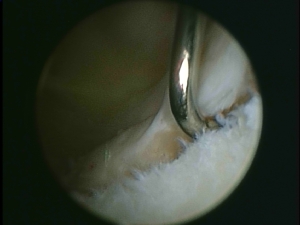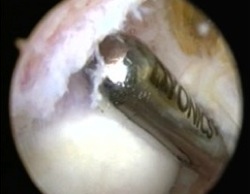Many shoulder and elbow operations which have traditionally been performed as open procedures can now be performed using arthroscopy (keyhole surgery on a joint). These range from simple diagnostic arthroscopy (just looking) to major reconstructive surgery. This has many potential advantages for patients including very small scars, less internal scarring, less pain, and a much faster recovery. Because of this, most shoulder and elbow arthroscopy operations can be performed as day cases (you don’t need to stay in hospital over night).
Shoulder Arthroscopy
Shoulder arthroscopy has developed enormously over the past 20 years. It is now possible to perform most shoulder operations arthroscopically provided the surgeon has the requisite training and experience.
The operation is performed under a general anaesthetic. For more complex arthroscopic surgery, the anaesthetist may also use a regional nerve block in order to numb the arm for 12-24 hours after the operation. A thin telescope (4.5mm in diameter) is introduced into the joint through a small incision (5-10mm), and specially designed fine instruments are used through separate small incisions in order to perform the surgery. The telescope is linked to a camera which allows a magnified image to be displayed on a monitor.
The following shoulder operations are now routinely performed in this manner:
- Arthroscopic subacromial decompression (ASD)
- Arthroscopic AC joint excision
- Arthroscopic rotator cuff repair
- Arthroscopic release of frozen shoulder
- Arthroscopic stabilisation
- Arthroscopic biceps tenodesis or tenotomy
Elbow Arthroscopy
Elbow arthroscopy is performed in a similar manner to shoulder arthroscopy, using several very small incisions around the elbow.
The following elbow operations can be performed arthroscopically:
- Arthroscopic removal of loose bodies
- Arthroscopic release of plica
- Arthroscopic osteocapsular release for elbow arthritis
- Arthroscopic capsular release for stiff elbow

